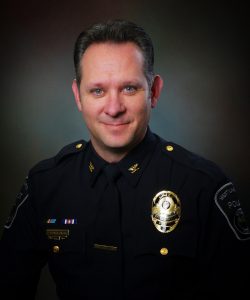Now, more than ever, is the opportunity for police chiefs to have meaningful conversations with their local civil rights organizations in a spirit of cooperation to ensure that all individuals’ rights are respected and protected. Finding common ground and working on shared goals together may be easier than one might think, particularly with the emergence of new technology and innovative solutions.
In early 2018, West Lafayette, Indiana, Chief of Police Jason Dombkowski began having conversations with the leadership of several civil rights organizations in Indiana. As the newly seated president of the Indiana Association of Chiefs of Police, Chief Dombkowski intended to focus on building relationships between other state-level stakeholder organizations, specifically the National Association for the Advancement of Colored People (NAACP) and the American Civil Liberties Union (ACLU). He asked the state leadership of these organizations, “If we could gather police chiefs from around our state in a closed-door room, what would you tell them? What do they need to hear? And finally, would you be interested in addressing such a gathering?” Leadership from the NAACP and the ACLU were appreciative of the call. They spoke at length about an opportunity for dialogue without a specific incident or event in the state necessitating a conversation. Both organizations had several thoughts to share, and both immediately accepted an invitation to address an assembly of police chiefs. Chief Dombkowski knew it would take some work to secure such a gathering of chiefs to listen to their important message. The groups met for the first time in Indianapolis in January 2018, and regular meetings of these three influential groups continue today.
Inevitably, their conversation landed squarely on police body-worn cameras as they attempted to find common ground and work toward solutions. It was noted by everyone at the table that body cams are a tangible and necessary solution to further government transparency and accountability. Still, there were also concerns about their use and possible misuse. Specifically, issues involving body camera capabilities, agency policies, and privacy concerns were raised by the NAACP and the ACLU. Leadership from both organizations emphasized the need for police departments to have an objective recording policy that required officers to record all interactions with the public from start to finish with few exceptions. The main points of concern are selective recording of police and public interactions or officers failing to record incidents for whatever reason, especially those incidents involving police use of force. At the same time, everyone acknowledged that asking officers to turn on their body cams before or even during a use-of-force incident was problematic—but absolutely necessary.
The Question: Why ask officers to turn on the body-worn camera during a potentially dangerous and stressful encounter when technology can do it for them?
First-generation body-worn cameras highlight the problems and frustrations of activating body cams under stress in the field. These body cams were relatively simplistic compared to the automated capabilities offered by some of today’s trailblazing body-worn camera providers. The first-generation body-worn camera systems required manual activation of the cameras and docking stations to offload recordings from the cameras.
Law enforcement technology has been continuously evolving and becoming more intelligent, and today’s body-worn cameras have advanced capabilities. Smart technology can automatically turn on the body-worn cameras for officers in the field, thus allowing for accurate policy-based recording.
The New Standard for Policy-Driven Automated Recording
In 2017, West Lafayette purchased a state-of-the-art second-generation body camera system and instituted the concept of Policy-Based (Automatic) Recording by embracing many of the newly available automatic recording triggers for body-worn cameras. These automatic recording triggers changed the entire premise of the agency’s long-standing body-worn camera program. By now placing the onus of recording and policy compliance on existing technology, the officers can focus on doing the already challenging job they are trained to do. Software-driven body-worn cameras and in-car video recording systems can be configured to automatically start or stop recording based on an agency’s specific recording policies, which, in turn, helps to promote efficiency, transparency, and accountability. The concept of policy-based recording delivers and ensures consistent, bias-free, and reliable automatic video recording. Policy-based recording provides consistently current compliance with an agency’s ever-evolving recording policies through over-the-air software updates to cameras in the field.
Installation of automated vehicle sensors allows for configurable decisions on when to start recording. For example, an agency might choose to have cameras turn on when the patrol vehicle’s emergency light bar is turned on and the door opens. Other vehicle sensors that can trigger automatic recording include rifle and shotgun locks, vehicle speed, and crash sensors. These automatic vehicle recording triggers now exist to help ensure compliance with recording policies.
New technology also allows for the body-worn cameras to activate automatically during a foot pursuit. With a built-in accelerometer, advanced cameras can detect when an officer is running and will automatically start recording.
Additional advanced safety features provide an officer down alert and activate the body-worn camera to record in the event an officer has become prone in the field and needs assistance. If an officer goes down, the system starts an automatic recording, recalls two minutes of video and audio before the incident, and alerts all nearby officers. The system also alerts command staff and sends the downed officer’s GPS coordinates, allowing quicker response times for responding officers. Most officers can think of an incident in their careers when this technology would have been helpful to have available.
Game-Changing Body-Worn Camera Automation
Even in the past year, more intelligent technology has been developed and made available for body-worn cameras. This technology includes activating cameras using computer-aided dispatch (CAD) calls, which allows for even more automation based on policy. CAD activation automatically records when an officer receives a CAD call for service. Action zones automatically turn the camera on to record when an officer enters a pre-defined geographical area, such as a neighborhood experiencing an active shooter event. Action zones can be created manually or from a CAD call for service.
In addition, smart holster sensors can now activate body-worn camera recording. When this activation is used, the camera also recalls two minutes of audio and video before the incident. The prepended video provides context to the situation that caused the officer to draw his or her firearm. Additionally, the smart holster sensor can alert all nearby officers and dispatch.
These technologically advanced, software-driven recording automations have significantly advanced the body-worn camera industry by ensuring officers adhere to an agency’s policies for recording video. Furthermore, officer down and smart holster sensor alerts and activation provide new increased safety measures for officers and the public.
The NAACP National Board of Directors has endorsed the use of policy-based automatic body-worn camera solutions for use by law enforcement. The NAACP believes the use of this technology aligns with their efforts toward continuous improvement in the overall protection of and accountability to communities. Recently, while working with law enforcement leaders on solutions including the use of policy-based automatic recording, Barbara Bolling-Williams, President of the Indiana NAACP State Conference and Member of the NAACP National Board of Directors said, “We built a bridge together, now let’s meet in the middle of that bridge.”
“We built a bridge together, now let’s meet in the middle of that bridge.”—Barbara Bolling-Williams, president of the Indiana NAACP State Conference and member of the NAACP National Board of Directors
As policy-based recording continues to become the new standard for body-worn camera programs, police departments benefit from improved policy compliance through the elimination of human error and implicit bias. Policy-based recording helps to ensure police chiefs have the video they need at the most critical moments and in full compliance with agency policy and community expectations. Policy-based recording via automation should be the new expectation of a department’s body-worn camera provider. Employing this advanced technology can increase public trust, agency transparency, and executive accountability in the communities they serve.
 Chief Jason Dombkowski retired in January 2019 after 25 years of service with the West Lafayette, Indiana, Police Department (WLPD), where he served as the city’s chief of police from 2008 to 2019. Currently, he is the director of law enforcement relations for BodyWorn by Utility, Inc. Under Chief Dombkowski’s leadership, the WLPD was the first law enforcement agency to deploy police body-worn cameras in Indiana, beginning in 2012. He is a U.S. Department of Justice body-worn camera subject matter expert, as well as a past president of the Indiana Association of Chiefs of Police. Chief Jason Dombkowski retired in January 2019 after 25 years of service with the West Lafayette, Indiana, Police Department (WLPD), where he served as the city’s chief of police from 2008 to 2019. Currently, he is the director of law enforcement relations for BodyWorn by Utility, Inc. Under Chief Dombkowski’s leadership, the WLPD was the first law enforcement agency to deploy police body-worn cameras in Indiana, beginning in 2012. He is a U.S. Department of Justice body-worn camera subject matter expert, as well as a past president of the Indiana Association of Chiefs of Police. |
BodyWorn by Utility, Inc. provides an integrated body camera, in-car video, and digital evidence management solution to law enforcement agencies across the United States. BodyWorn is the industry leader in Policy-Based Recording, incorporating real-time communications and multiple exclusive automatic video and audio recording triggers based on policies, such as
bodyworn.com | 1-800-597-4707 |



